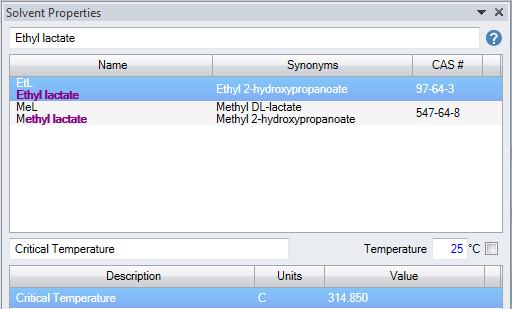Up to 59 constant properties and 15 temperature dependent properties for materials.
- Example of properties include Liquid Density, Liquid Viscosity or the CAS number for the different solvents.
- Each of the temperature dependent properties can be queries over a range of temperatures.
A full list of solvent properties is given below
Table 1.- List of the 15 temperature dependent properties
| Liquid Density | Liquid Thermal Conductivity | Solid Density | Vapor Thermal Conductivity | Second Virial Coefficient |
| Liquid Heat Capacity | Vapor Pressure of Liquid | Solid Specific Heat Capacity | Vapor Pressure of Solid | Vapor Viscosity |
| Liquid Viscosity | Heat of Vaporization | Solid Thermal Conductivity | Ideal Gas Specific Heat Capacity | Surface Tension |
Table 2.- List of the 59 constant properties
| Short Name | Critical Pressure | Auto Ignition Temperature |
| Long Name | ACS Greenness Health | Heat of Sublimation |
| Synonym | GSK Guide 2009 Flammability and Explosion | Enthalpy of Formation for Ideal Gas |
| CAS Number | Critical Volume | Gibbs Energy of Formation for Ideal Gas |
| Hill Formula | Critical Compressibility Factor | Absolute Entropy of Ideal Gas |
| Formatted Hill Formula | Melting Point at 1 atm | Standard State Enthalpy of Formation |
| Linear Formula | ACS Greenness Env (Air) | Standard State Gibbs Energy of Formation |
| Formatted Linear Formula | GSK Guide 2009 Reactivity/Stability | Standard State Absolute Entropy |
| SMILES | ACS Greenness Env (Water) | Enthalpy of Fusion at Melting Point |
| IUPAC Identifier | Triple Point Temperature | Net Standard Enthalpy of Combustion |
| InChI Key | ACS Greenness Env (Reactivity/Stability) | Acentric Factor |
| Solvent Family | GSK Guide 2009 Life Cycle Score | Radius of Gyration |
| Molar Mass | Triple Point Pressure | Solubility Parameter |
| Relative Van der Waals Volume, R | Normal Boiling Point | Dipole Moment |
| Relative Van der Waals Surface Area, Q | Liquid Molar Volume | Van der Waals Reduced Volume |
| Solvent Class | Flash Point | Van der Waals Surface Area |
| GSK Guide 2009 Solvent Class | Lower Flammability Limit % | Refractive Index |
| Critical Temperature | Lower Flammability Limit Temperature | Parachor |
| ACS Greenness Safety | Upper Flammability Limit % | Dielectric Constant |
| GSK Guide 2009 Waste | Upper Flammability Limit Temperature |
Searching for the Critical Temperature for ethyl lactate:
Type ethyl lactate in the textbox and select it. In the next textbox below, type in Critical Temperature. A sample output is shown below:

Searching for the Liquid Specific Heat Capacity for n-heptane at 25 C:
Type in heptane (or n-heptane) in the first text box. In the next textbox below, type in the physical property that you want to search (in this case Liquid Specific Heat Capacity). To the right of this textbox, type in the Temperature that you want (in this case).
Finding the vapor pressure for THF at 25C:
Type in the name THF in the first textbox. In the next section, check the box that is located to the right of Temperature. This will list all the temperature dependent properties. Look down the list of temperature dependent properties, until you find the required value (in this case the Vapor Pressure of Liquid).
All values returned by the solvent properties can be written back to the current document or worksheet (at the current position) by clicking on either the Write with Details or Write Value buttons. The former give a table output (shown below) whereas the Write Value option just inserts the value into the document.
| Solvent | Property | Value | Unit |
| Ethyl acetate | Liquid Density | 893.613 | kg/m3 |
There is another option to 'Write Structure' that inputs the structure of the solvent into the worksheet or document. The number of decimal places can be modified using the decimal place roller  .
.